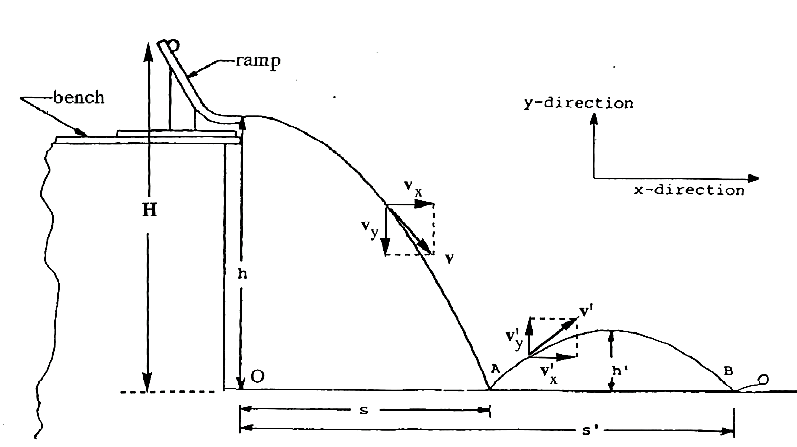courses:phy101l:m1
Table of Contents
M1. Projectile motion
Introduction
You can sometimes get a lot of information from a small amount of data. In this experiment, you will roll a ball down a ramp and let it bounce a couple of times on the floor.
You need to know the height from which the ball is released, the height of the end of the ramp, the position of the first two bounces of the ball and its mass.
From this information, you will be able to determine the initial and final velocity, the initial and final kinetic energy, and the initial and final momentum—before and after the ball bounces.
Theory
Data and method
Apparatus
- Marble ball or plumb ball
- Ramp
- Recording paper
- Carbon paper
- Meter scale
- Weight scale
Procedure
Set up the apparatus as shown in the figure below.

- Make sure the end of the ramp looks level with the table. Lay down a piece of recording paper on the floor and place a sheet of carbon paper on top. Each bounce of the ball will leave a mark on the recording paper.
- Once the equipment is aligned, do not move the collision box or recording paper until the data collection is completed. However, the carbon paper can be lifted at any time to inspect the collision points. Locate the position $O$ on the floor using the marble ball and measure the distance from $O$ to a reference point on the recording paper. This allows the paper to be moved after the data collection is completed to a more suitable location for the measurements of $s$ and $s'$.
- To collect the data, release the ball from a point near the top of the ramp, being careful not to impart any spin on the ball. This allows the ball to roll down the ramp and bounce on the floor with minimal spin. Repeat the procedure 10 times, always releasing the ball from the same point on the ramp. Measure the height of the first bounce $h' \pm \delta h'$ using a meter scale.
- Measure the height of the end of the ramp $h \pm \delta h$, and the height of the release position of the ball $H \pm \delta H$ (near the top of the ramp) above the floor. Measure the mass $m$ of the ball.
- From the recording paper, obtain the average values of $s$ and $s'$ in the following way. By eye, determine the circular region that include most of the marks on the paper (ignore any points that are obviously anomalous). Draw the circle around this region. Take the center of the circles for $s$ and $s′$. The radius of the circle as the uncertainty $\delta s$ and $\delta s'$ , respectively.
Data
Analysis and results
Discussion
Conclusion
courses/phy101l/m1.txt · Last modified: by 127.0.0.1
